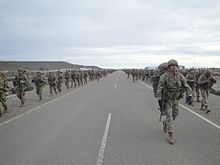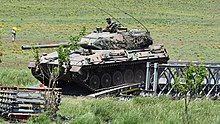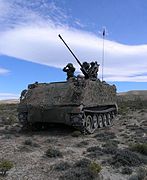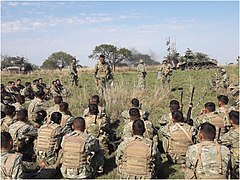Argentine Army
| Argentine Army | |
|---|---|
| Ejército Argentino | |
 Seal | |
| Founded | May 29, 1810 |
| Country | |
| Branch | Army |
| Size |
|
| Part of | Argentine Armed Forces |
| Motto(s) | "Born with the Fatherland in May 1810" |
| March | Song of the Argentine Army |
| Anniversaries | Army Day (29 May) |
| Equipment | Equipment of the Argentine Army |
| Engagements | List
|
| Website | argentina.gob.ar/ejercito |
| Commanders | |
| Commander-in-chief | PresidentJavier Milei |
| Chief of General Staff | Brigadier General Carlos Alberto Presti |
| Deputy Chief of General Staff | Brigadier General Carlos Alberto Carugno |
| Insignia | |
| Identification symbol |  |
TheArgentine Army(Spanish:Ejército Argentino, EA) is theland forcebranch of theArmed Forces of the Argentine Republicand the senior military service ofArgentina.Under theArgentine Constitution,thepresident of Argentinais thecommander-in-chiefof the Armed Forces, exercising his or her command authority through theMinister of Defense.
The Army's official foundation date is May 29, 1810 (celebrated in Argentina as theArmy Day), four days after theSpanish colonial administration in Buenos Aires was overthrown.The new national army was formed out of several pre-existing colonial militia units and locally manned regiments; most notably theInfantry Regiment "Patricios",which to this date is still an active unit.
History[edit]


Several armed expeditions were sent to the Upper Peru (nowBolivia),Paraguay,UruguayandChileto fight Spanish forces and secure Argentina's newly gainedindependence.The most famous of these expeditions was the one led by GeneralJosé de San Martín,who led a 5000-man army across theAndes Mountainsto expel the Spaniards from Chile and later from Perú. While the other expeditions failed in their goal of bringing all the dependencies of the formerViceroyalty of the Río de la Plataunder the new government in Buenos Aires, they prevented the Spaniards from crushing the rebellion.

During the civil wars of the first half of the nineteenth century, the Argentine Army became fractionalized under the leadership of the so-calledcaudillos( "leaders" or "warlords" ), provincial leaders who waged a war against the centralist Buenos Aires administration. However, the Army was briefly re-unified during the war with theBrazilian Empire(1824–1827).
It was only with the establishment of a constitution (which explicitly forbade the provinces from maintaining military forces of their own) and a national government recognized by all the provinces that the Army became a single force, absorbing the older provincial militias. The Army went on to fight theWar of the Triple Alliancein the 1860s together with Brazil and Uruguay against Paraguay. After that war, the Army became involved in Argentina'sConquista del Desierto( "Conquest of the Desert" ): the campaign to occupyPatagoniaand root out the natives, who conducted looting raids throughout the country.
1880–1960s[edit]
Between 1880 and 1930, the Army sought to become a professional force without active involvement in politics, even though many a political figure -PresidentJulio Argentino Roca,for example- benefitted from a past military career. The Army prevented the fall of the government in a number ofRadical-led uprisings. Meanwhile, the military in general and the Army, in particular, contributed to develop Argentina's unsettled southern frontier and its nascent industrial complex.
The main foreign influence during this period was, by and large, thePrussian(and thenGerman) doctrine. Partly because of that, during bothWorld Warsmost of the officers supported the Germans, more or less openly, while theArgentine Navyfavored theBritishinstead.

In 1930, a small group of Army forces (not more than 600 troops) deposed PresidentHipólito Yrigoyenwithout much response from the rest of the Army and theNavy.This was the beginning of a long history of political intervention by the military. Another coup, in 1943, was responsible for bringing an obscure colonel into the political limelight:Juan Perón.
Even though Perón had the support of the military during his two consecutive terms of office (1946–1952 and 1952–1955), his increasingly repressive government alienated many officers, which finally led to a military uprising which overthrew him in September 1955. Between 1955 and 1973 the Army and the rest of the military became vigilant over the possible re-emergence of Peronism in the political arena, which led to two new coups against elected Presidents in 1962 (deposingArturo Frondizi) and 1966 (oustingArturo Illia). Political infighting eroded discipline and cohesion within the army, to the extent that there was armed fighting between contending military units during the early 1960s.
1960s and the military junta[edit]
The military government ruled Argentina between 1966 and 1973. During that decade the saw the rise of several terrorist groups includingMontonerosand theERP.DuringHéctor Cámpora's first months of government, a rather moderate and left-wing Peronist, approximatively 600 social conflicts, strikes andfactory occupationstook place.[1]Following the June 20, 1973Ezeiza massacre,left and right-wing Peronism broke apart, and theTriple Aa far-right terrorist group founded byJosé López Rega,the right-hand man ofJuan Peronand, later,Isabel Perón,started a campaign of terror and death against any perceived political rivals. Isabel Perón herself was ousted during theMarch 1976 coupby a militaryjunta.
The new military government, self-namedProceso de Reorganización Nacional,initially tried to end the guerrilla's campaigns, but the nation rapidly descended into a state of civil unrest. Terrorist organisations and guerilla movements where often met with a mixture of state terror and general paranoia. The civilian population was now caught in a police state between a paranoid and brutal military dictatorship and violent dissident communist guerrillas. The PRN called this period the "Dirty War"— a term refused by jurists during the 1985Trial of the Juntas.Batallón de Inteligencia 601(the 601st Intelligence Battalion) became infamous during this period. It was a special militaryintelligence serviceset up in the late 1970s, active in theDirty WarandOperation Condor,and disbanded in 2000.[2]Its personnel collected information on and infiltratedguerrillagroups andhuman rightsorganisations, and coordinated killings,kidnappingsand other abuses. The unit also participated in the training of NicaraguanContraswith US assistance, including fromJohn Negroponte.
"Annihilation decrees"[edit]

Meanwhile, theGuevaristPeople's Revolutionary Army(ERP), led by Roberto Santucho and inspired byChe Guevara'sfoco theory,began a rural insurgency in the province ofTucumán,in the mountainous northwest of Argentina. It started the campaign with no more than 100 men and women of the Marxist ERP guerrilla force and ended with about 300 in the mountains (including reinforcements in the form of the elite Montoneros 65-strong "Compañía de Monte" (Jungle Company) and the ERP's "Decididos de Córdoba" Urban Company),[3]which the Argentine Army managed to defeat, but at a cost.
On 5 January 1975, an ArmyDHC-6transport plane was downed near the Monteros mountains, apparently shot down by the Guerrillas.[4]All thirteen on board were killed. The military believe a heavy machine gun had downed the aircraft.[5]

In response,Ítalo Luder,President of the National Assembly who acted as interim President substituting himself to Isabel Perón who was ill for a short period, signed in February 1975 the secret presidential decree 261, which ordered the army to neutralize and/or annihilate the insurgency inTucumán,the smallest province of Argentina.Operativo Independenciagave power to the Armed Forces to "execute all military operations necessary for the effects of neutralizing or annihilating the action of subversive elements acting in the Province of Tucumán."[6][7]Santucho had declared a 620-mile (1,000 km) "liberated zone" in Tucuman and demanded Soviet-backed protection for its borders as well as proper treatment of captured guerrillas as POWs.[8]
The Argentine Army Fifth Brigade, then consisting of the 19th, 20th and 29th Mountain Infantry Regiments[9]and commanded by Brigadier-GeneralAcdel Vilasreceived the order to move toFamaillain the foothills of the Monteros mountains on 8 February 1975. While fighting the guerrillas in the jungle, Vilas concentrated on uprooting the ERP support network in the towns, using tactics later adopted nationwide, as well as a civic action campaign.
By July 1975, anti-guerrilla commandos were mountingsearch-and-destroymissions in the mountains. Army special forces discovered Santucho's base camp in August, then raided the ERP urban headquarters in September. Most of the Compañia de Monte's general staff was killed in October and was dispersed by the end of the year.[10]
The leadership of the rural guerrilla force was mostly eradicated and many of the ERP guerrillas and civilian sympathizers in Tucumán were either killed or forcefully disappeared. Efforts to restrain the rural guerrilla activity to Tucumán, however, remained unsuccessful despite the use of 24 recently arrived US-made BellUH-1HHuey troop-transport helicopters. In early October, the 5th Brigade suffered a major blow at the hands of the Montoneros, when more than one hundred, and possibly several hundred [11]Montoneros and supporters were involved in theOperation Primicia,the most elaborate operation of the "Dirty War", which involved hijacking a civilian airliner, taking over the provincial airport, attacking the 29th Infantry Regiment (which had retired to barracks inFormosa province) and capturing its cache of arms, and finally escaping by air. Once the operation was over, they escaped towards a remote area inSanta Fe province.The aircraft, aBoeing 737,eventually landed on a crop field not far from the city of Rafaela.
In the aftermath, twelve soldiers and two policemen[12]were killed and several wounded. The sophistication of the operation, and the getaway cars and safehouses they used to escape from the crash-landing site, suggest several hundred guerrillas and their supporters were involved.[13]The Argentine security forces admitted to 43 army troops killed in action in Tucuman, although this figure does not take into account police and Gendarmerie troops, and the soldiers who died defending their barracks in Formosa province on 5 October 1975. By December 1975, the Argentine military could, with some justification claim that it was winning the 'Dirty War', but it was dismayed to find no evidence of overall victory.
On 23 December 1975, several hundred ERP fighters[14]with the help of hundreds of underground supporters, staged an all-out battle with the 601st Arsenal Battalion nine miles (14 km) from Buenos Aires and occupied four local police stations and a regimental headquarters.[15]63 guerrillas,[16]seven army troops and three policemen were killed.[17]In addition 20 civilians were killed in the crossfire. Many of the civilian deaths occurred when the guerrillas and supporting militants burned 15 city buses[18]near the arsenal to hamper military reinforcements. This development was to have far-reaching ramifications. On 30 December 1975, urban guerrillas exploded a bomb inside the Army's headquarters in Buenos Aires, injuring at least six soldiers.[19]
The Montoneros movement successfully utilized divers in underwater infiltrations and blew the pier where the Argentine destroyerARA Santísima Trinidadwas being built, on 22 August 1975. The ship was effectively immobilized for several years.
French cooperation[edit]
French journalistMarie-Monique Robinhas found in the archives of theQuai d'Orsay,the French Minister of Foreign Affairs, the original document proving that a 1959 agreement between Paris and Buenos Aires instaured a "permanent French military mission," formed of veterans who had fought in theAlgerian War,and which was located in the offices of the chief of staff of the Argentine Army. She showed howValéry Giscard d'Estaing's government secretly collaborated withJorge Rafael Videla's juntain Argentina and withAugusto Pinochet's regime in Chile.[20]
Green deputiesNoël Mamère,Martine BillardandYves Cochetdeposed on September 10, 2003, a request for the constitution of a Parliamentary Commission on the "role of France in the support of military regimes in Latin America from 1973 to 1984" before the Foreign Affairs Commission of the National Assembly, presided byEdouard Balladur.Apart fromLe Monde,newspapers remained silent about this request.[21]However, deputyRoland Blum,in charge of the commission, refused to hear Marie-Monique Robin, and published in December 2003 a 12 pages report qualified by Robin as the summum of bad faith. It claimed that no agreement had been signed, despite the agreement found by Robin in theQuai d'Orsay[22][23]
When Minister of Foreign AffairsDominique de Villepintraveled to Chile in February 2004, he claimed that no cooperation between France and the military regimes had occurred.[24]
Falklands war[edit]

On 2 April 1982,Leopoldo Galtieriinitiated the1982 invasion of the Falkland Islandsor Operation Rosario as a result of negotiations with theUnited Kingdomrunning long.[25]The Argentine Army contributed forces to Operation Rosario andoccupationthat followed. Army forces also opposed the amphibious landing inSan Carlos Wateron 21 May, and fought the British atGoose Green,Mount Kent, and the battles aroundPort Stanleythat lead to the ceasefire of 14 June followed by thesurrender of the Argentinetroops.[26]
The Argentine Army suffered 194 men killed and 1,308 wounded and lost much equipment.[27]The war left the army weakened in equipment, personal, moral and supremacy in the region. TheDirty Warevents, coupled with the defeat in theFalklands War,precipitated the fall of the military junta that ruled the country, then enters the GeneralReynaldo Bignone,who began the process of return to democracy in 1983.
1980s to present[edit]

Since the return to civilian rule in 1983, the Argentine military have been reduced both in number and budget and, by law, cannot intervene anymore in internal civil conflicts. They became more professional, especially afterconscriptionwas abolished.
In 1998, Argentina was grantedMajor non-NATO allystatus by the United States. The modern Argentine Army is fully committed to internationalpeacekeepingunderUnited Nationsmandates, humanitarian aid and emergencies relief.
In 2010, the Army incorporated ChineseNorincoarmored wheeledAPCsto deploy with itspeacekeepingforces.[28]
In 2016 PresidentMauricio Macrimodified a decree made by the 1984 government ofRaúl Alfonsínwhich had removed much of the military's autonomy.[29]
A major problem of today's Army is that most of its combat units are understrength in manpower due to budgetary limitations; the current Table of Organization and Equipment being established at a time during which the Army could rely on larger budgets and conscripted troops.[30]Current plans call for the expansion of all combat units until all combat units are again full-strength, as soon as budget constraints allow for the induction of new volunteer service personnel of both genders.
Structure[edit]
Army General Staff[edit]


The Army is headed by a Chief of General Staff directly appointed by the President. The current Chief of the General Staff (since September 2008) is General Luis Alberto Pozzi.[31]The General Staff of the Army (Estado Mayor General del Ejército) includes the Chief of Staff, a Deputy Chief of the General Staff and the heads of the General Staff's six departments (Jefaturas). The current departments of the General Staff (known also by their Roman numerals) are:
There are also a number of Commands and Directorates responsible for development and implementation of policies within the Army regarding technological and operational areas. They also handle administrative affairs. As of 2020, these include the following:
- Communications and Computer Directorate (Dirección General de Comunicaciones e Informática)
- Education Directorate (Dirección General de Educación)
- Engineers and Infrastructure Directorate (Dirección de Ingenieros e Infraestructura)
- Remount and Veterinary Directorate (Dirección de Remonta y Veterinaria)
- Health Directorate (Dirección General de Salud)
- Personnel and Welfare Directorate
- Materiel Directorate (Dirección General de Material)
- Intelligence Directorate
- Organization and Doctrine Directorate
- Research and Development Directorate (Dirección General de Investigación y Desarrollo)
- Planning Directorate (Dirección de Planeamiento)
- Finance Directorate
- Historical Service Directorate
Field organization[edit]

In the 1960s, the Army was reorganised into five Army Corps. This structure replaced the old structure based on divisions following the French model. There was a further reorganisation in 1991, when brigades were assigned to six new divisions, two stationed at Santa Cruz and Mendoza.[32]
Until late 2010, the First, Second and Third Army Divisions were designated as the Second, Third and Fifth Army Corps (Cuerpos de Ejército) respectively, without any intermediate division-level commands. These redesignations took place as part of a major reorganization of the Armed Forces' administrative and command structure. Two additional Army Corps, the First and Fourth, had already been dissolved in 1984 and 1991 respectively, with their dependent units reassigned to the remaining three Army Corps.
As of 2011, army forces are geographically grouped into three Army Divisions (Divisiones de Ejército), each roughly equivalent in terms of nominal organization to a U.S. Army division (+). Each Army Division has an area of responsibility over a specific region of the country; First Army Division covers the northeast of the country, Second Army Division covers the center and northwest of Argentina and Third Army Division covers the south andPatagonia.In addition to the three Army Divisions, the Rapid Deployment Force (Fuerza de Despliegue Rápido,FDR) forms an additional fourth divisional-level formation, while the Buenos Aires Military Garrison operates independently from any division-sized command. There are also several separate groups, including an anti-aircraft group and theArgentine Army Aviationgroup.
Each division has varying numbers ofbrigadesof armor, mechanized forces and infantry.
As of 2011, the Argentine Army has eleven brigades:
- two armored brigades (1st and 2nd),
- three mechanized brigades (9th, 10th and 11th),
- three mountain brigades (5th,6thand8th),
- one paratrooper brigade (4th) and
- two bush brigades (3rd and12th).
Note: The 7th Infantry Brigade was dissolved in early 1985, while the 3rd Infantry Brigade was converted into a motorized training formation, which was ultimately dissolved in 2003.

Depending on its type, each brigade includes two to five Cavalry or Infantry Regiments, one or two Artillery Groups, a scout cavalry squadron, one battalion or company-sized engineer unit, one intelligence company, one communications company, one command company and a battalion-sized logistical support unit. The terms "regiment" and "group", found in the official designations of cavalry, infantry and artillery units, are used due to historical reasons. During theArgentine War of Independence,the Argentine Army fielded traditional regiment-sized units. 'Regiments' are more accurately described as battalions; similar-sized units that do not belong to the above-mentioned services are referred to as "battalions". In addition to their service, Regiments and Groups are also specialized according to their area of operations (Mountain Infantry, Jungle Infantry, Mountain Cavalry), their equipment (Tank Cavalry, Light Cavalry, Mechanized Infantry) or their special training (Paratroopers, Commandos, Air Assault,Mountain CazadoresorJungle Cazadores). Regiments are made up by four maneuver sub-units (companies in infantry regiments and squadrons in cavalry regiments) and one command and support sub-unit for a total of 350 to 700 troops.
In 2006, aRapid Deployment Forcewas created based on the4th Paratrooper Brigade.
In 2008, aSpecial Operations Forces Groupwas created comprising two Commando Companies, one Special Forces Company and onepsychological operationscompany.
Equipment[edit]
Ranks[edit]
Insignia for all ranks except volunteers is worn on shoulder boards. Ranks from colonel major onwards use red-trimmed shoulderboards and the suns denoting rank are gold-braid; the suns on other officers' shoulder boards are metallic. Generals also wear golden wreath leaves on their coat lapels.
The rank insignia for volunteers 1st class, 2nd class and commissioned 2nd class is worn on the sleeves. Collar versions of the ranks are used in combat uniforms.
The highest army rank in use is lieutenant-general. A higher army rank, captain-general, was awarded twice in the nineteenth century: toJosé de San Martínand toBernardino Rivadavia.As a promotion to this rank is not foreseen, no insignia for the rank currently exists.
Officers[edit]
| Rank group | General / flag officers | Senior officers | Junior officers | Officer cadet | ||||||||||||||||||||||||||||||||
|---|---|---|---|---|---|---|---|---|---|---|---|---|---|---|---|---|---|---|---|---|---|---|---|---|---|---|---|---|---|---|---|---|---|---|---|---|

|

|

|

|

|

|

|

|

|

|

|
||||||||||||||||||||||||||
| Teniente general | General de división | General de brigada | Coronel mayor | Coronel | Teniente coronel | Mayor | Capitán | Teniente primero | Teniente | Subteniente | ||||||||||||||||||||||||||
The rank ofcoronel mayor(senior colonel) is an honorary distinction for colonels occupying general's positions (such asbrigadecommander), but who are not senior enough to be promoted.[34]
NCOs and enlisted[edit]
| Rank group | Senior NCOs | Junior NCOs | Enlisted | |||||||||||||||||||||||||||||||||
|---|---|---|---|---|---|---|---|---|---|---|---|---|---|---|---|---|---|---|---|---|---|---|---|---|---|---|---|---|---|---|---|---|---|---|---|---|

|

|

|

|

|

|

|

|

|

| |||||||||||||||||||||||||||
| Suboficial mayor | Suboficial principal | Sargento ayudante | Sargento primero | Sargento | Cabo primero | Cabo | Voluntario primero | Voluntario segundo | Soldado de segunda en comisión | |||||||||||||||||||||||||||
Image gallery[edit]
-
"Air cavalry" of the Argentine Army.
-
TwoTAM VCAin exercise.
-
Medium Argentine Tank.
-
Self-propelled mortar VCTM opening fire.
-
ArgentineM-113equipped with AA cannon.
-
Unimogtruck of the Argentine Army.
-
Argentine Army Exploration Squadron.
-
Argentine Infantry.
-
Argentine soldiers on surveillance at the border.
-
Argentine soldiers receiving instructions before exercise.
-
communications platoon of the Argentine army.
-
Argentine hunter infantry.
-
REO M35 truck
-
Bell UH-1 Huey of the Argentine Army
-
Armored infantry in M-113s
See also[edit]
References[edit]
Citations[edit]
- ^Hugo Moreno,Le désastre argentin. Péronisme, politique et violence sociale (1930–2001),Editions Syllepses,Paris, 2005, p.109(in French)
- ^"Buenos Aires News – Argentina reveals secrets of 'dirty war'".Archived fromthe originalon 14 May 2013.Retrieved24 December2014.
- ^Paul H. Lewis,Guerrillas & Generals: The "Dirty War" in Argentina,Praeger Paperback, 2001, p. 126.
- ^John Keegan, World Armies|page=22, Macmillan, 1983
- ^TUCUMAN 1975: Avión del Ejército Argentino es derribado con ametralladoras antiaéreasArchived2011-07-06 at theWayback Machine
- ^"[E]l commando general del Ejército procederá a ejecutar todas las operaciones militares que sean necesarias a efectos de neutralizar o aniquilar el accionar de los elementos subversivos que actúan en la provincia de Tucumán"(in Spanish)
- ^Decree No. 261/75Archived2006-11-15 at theWayback Machine.NuncaMas.org,Decretos de aniquilamiento.
- ^Facts on File, p. 126 (1975)
- ^English, Adrian J.Armed Forces of Latin America: Their Histories, Development, Present Strength, and Military Potential,Janes Information Group, 1984, p. 33
- ^Times, Juan de Onis Special to The New York (1975-11-11)."Guerrillas in Argentina Battle Army in a War Without Prisoners".The New York Times.ISSN0362-4331.Retrieved2023-05-13.
- ^Martha Crenshaw (1995).Terrorism in Context.p. 236.ISBN978-0-271-01015-1.
- ^"The Montreal Gazette – Google News Archive Search".Retrieved24 December2014.
- ^"The Sydney Morning Herald – Google News Archive Search".Retrieved24 December2014.
- ^"monte chingolo guerrillas and generals – Google Search".Retrieved24 December2014.
- ^ Troops fight off guerrillas,The Rock Hill Herald,22 December 1975
- ^Monte Chingolo: Voces de ResistenciaArchived2009-11-30 at theWayback Machine
- ^"Argentina: Hanging from the Cliff".Time.5 January 1976.
- ^"The Windsor Star – Google News Archive Search".Retrieved24 December2014.
- ^"Argentine theatre hit by bomb"The Spokesman-Review31 December 1975
- ^ConclusionofMarie-Monique Robin'sEscadrons de la mort, l'école française(in French)
- ^MM. Giscard d'Estaing et Messmer pourraient être entendus sur l'aide aux dictatures sud-américaines,Le Monde,September 25, 2003(in French)
- ^« Série B. Amérique 1952–1963. Sous-série: Argentine, n° 74. Cotes: 18.6.1. mars 52-août 63 ».
- ^RAPPORT FAIT AU NOM DE LA COMMISSION DES AFFAIRES ÉTRANGÈRES SUR LA PROPOSITION DE RÉSOLUTION (n° 1060), tendant à la création d'une commission d'enquête sur le rôle de la France dans le soutien aux régimes militaires d'Amérique latine entre 1973 et 1984, PAR M. ROLAND BLUM,French National Assembly(in French)
- ^Argentine: M. de Villepin défend les firmes françaises,Le Monde,February 5, 2003(in French)
- ^"Falkland Islands War | Summary, Casualties, Facts, & Map | Britannica".britannica.Retrieved2023-05-13.
- ^"Operación Rosario".Argentina.gob.ar.Argentine Ministry of Defence. 7 May 2018.Retrieved8 June2018.
- ^"1.657 heridos 1.308 del Ejército 303 de la Armada 46 de la Fuerza Aérea." Historia Marítima Argentina, p. 137, Argentina. Departamento de Estudios Históricos Navales Cuántica Editora, 1993
- ^vehículos Norinco de reciente provisión
- ^Rivas Molina, Federico (June 3, 2016)."Mauricio Macri reduce el control civil sobre las Fuerzas Armadas".El País(in Spanish).RetrievedAugust 30,2017.
- ^"Argentina Military Spending/Defense Budget 1960-2023".macrotrends.net.Retrieved2023-05-13.
- ^Nueva, La."La Nueva".lanueva(in Spanish).Retrieved2019-03-09.
- ^Jane's Defence Weekly2 February 1991
- ^ab"Grados".argentina.gob.ar(in Spanish). Government of Argentina.Retrieved27 May2021.
- ^"Coronel Mayor y Comodoro de Marina"(PDF).Archived fromthe original(PDF)on 2016-09-10.Retrieved2013-06-08.
Sources[edit]
- International Institute for Strategic Studies(2010-02-03). Hackett, James (ed.).The Military Balance 2010.London:Routledge.ISBN978-1-85743-557-3.
Further reading[edit]
- Garcia Loperena, Gaston Javier (August 2016).El Unimog en el Ejercito Argentino(in Spanish) (1st ed.). 1884 Editorial – Buenos Aires (2015).ISBN9789509822993.Archived fromthe originalon 2017-01-22.Retrieved2016-10-27.
- Garcia Loperena, Gaston Javier (March 2015).Vehiculos Tacticos del Ejercito Argentino(in Spanish) (1st ed.). 1884 Editorial – Buenos Aires (2014).ISBN9789509822962.Archived fromthe originalon 2017-01-22.Retrieved2016-10-27.
External links[edit]
- Official website
 (in Spanish)
(in Spanish) - Organization and equipmenton Saorbats
- Globalsecurity.org – Argentine Army – Equipment (page updated 05-02-2015)(accessed 2015-02-28)
















